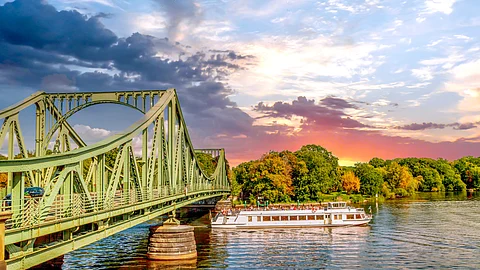
- Destinations
- Experiences
- Stay
- What's new
- Celebrating People
- Responsible Tourism
- CampaignsCampaigns
- Subscribe
- Buy Now

Germany is a country that is rich in history and culture, and it has many famous landmarks that have played a significant role in its past. One of the most iconic landmarks is the Glienicke Bridge, which is also known as the 'Bridge of Spies.' This bridge is a symbol of the Cold War and the diplomatic exchanges that took place during that period. Since then, the bridge has been an iconic landmark and a subject of much discussion and culture. Find out all you need to learn about the bridge's history, cultural significance, architecture and the attractions that surround it. Join us on a journey across this historic bridge and discover its fascinating story.
The Glienicke Bridge is a historic bridge that spans the Havel River, connecting the beautiful cities of Potsdam and Berlin. It was constructed in 1907 and was initially built to connect the Prussian residences of Babelsberg and Glienicke. However, during the Cold War, it became famous for spy exchanges between the United States and the Soviet Union. The bridge was the site of many notable exchanges, including the release of American U-2 pilot Francis Gary Powers in 1962. Due to its historic significance, the Glienicke Bridge is also known as the ‘Bridge of Spies,’ which was inspired by the 2015 Spielberg film that brought this history to the silver screen.
While walking across the Glienicke Bridge, you will be surrounded by the rich history of Germany. The landscape is adorned with castles and palaces, which reflects the grandeur of Prussian royalty. The Glienicke Bridge is an elegant steel construction combining form and function. Its distinctive arches and intricate latticework showcase early 20th-century engineering. In 1834, Karl Friedrich Schinkel designed a brick and wood bascule bridge. By the early 20th century, the bridge could not manage the increasing traffic volume. The bridge's moveable sections were causing delays in the Havel River's steamer traffic.
In 1904, the Prussian government organised a design competition to replace Schinkel's bridge with a modern iron bridge. The Johann Caspar Harkort Company of Duisburg won the competition with their design. The new bridge was inaugurated on 16 November 1907 and is still in use today.
Take your time to admire the bridge's architectural details as you stroll across it, and imagine the secret exchanges beneath its graceful arches. It is a historical site and a living testimony to Germany's commitment to remembering and reconciling its past. Visitors can find interpretative plaques and information boards along the bridge that provide insights into its espionage-laden past to ensure that the lessons of the Cold War are not forgotten.
The area surrounding the bridge has a lot of attractions to offer. One of them is Babelsberg Park, which is a UNESCO World Heritage site. Visitors can explore the beautiful gardens, historical buildings and charming lakeside promenades. Cecilienhof Palace, located nearby, was the site of the Potsdam Conference in 1945. It can help visitors gain a deeper understanding of post-war diplomacy. After a day of exploring, enjoy Potsdam and Berlin's diverse culinary offerings. These local restaurants cater to every palate, from traditional German cuisine to international flavours. You can savour a hearty bratwurst or indulge in a delicate schnitzel while reflecting on the history you've encountered.
The Glienicke Bridge has played a significant role in history as a location for prisoner exchanges. It has also inspired artists in the realm of fiction. In the 1966 film "Funeral in Berlin," the bridge was used for a prisoner exchange scene. The British band T'Pau named their debut album's title track "Bridge of Spies" after this bridge. Moreover, the Glienicke Bridge was also featured in the TV series "Codename: Kids Next Door" and the animated series "Archer." The 2015 film "Bridge of Spies," directed by Steven Spielberg and starring Tom Hanks, brought the historical significance of the bridge to a global audience.
Through these varied artistic interpretations, the Glienicke Bridge has become more than just a physical structure. It has become a symbol of intrigue, espionage, and the human connections forged on its historic span. Whether in spy thrillers, music, children's shows, or major Hollywood productions, the 'Bridge of Spies' continues to capture our collective imagination and weave its story into the fabric of creative expression.
To reach the Glienicke Bridge via public transportation, you can take the 316 bus from Wannsee station to the Glienicke Lake stop. The bus journey takes approximately 1 hour and 50 minutes from central Berlin.
Alternatively, you can take the S-Bahn train to Potsdam, which takes around 40 minutes. From Potsdam station, you can hop on the 93 tram that will take you to the bridge.
The Glienicke Bridge is located in the south and connects Berlin and Potsdam. The bridge and garden of Glienicke Castle are open to the public, free of charge.
